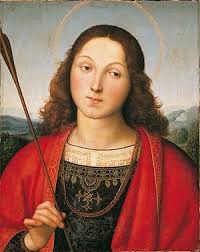I have argued on this site that Giorgione’s Portrait of a Young Woman, commonly called “Laura” could actually be his version of “The Conversion of Mary Magdalen.” I believe that I am not the first to suggest Mary Magdalen but a number of distinguished catalogs in the past two decades do not even consider the possibility.
 |
| Giorgione: Portrait of a Young Woman (Laura) Oil on canvas, mounted on panel, 51 x 33.6 cm Kunsthistorisches Museum, Vienna |
While scholars are unanimous in attributing the Laura to Giorgione, they have not been able to agree on the subject of this painting of a partially nude young woman. Most agree that Laura is a misnomer and that the painting has nothing to do with Petrarch's lover. All do point out the paradoxical iconographic symbols. On one hand, there are the robe and bared breast of a Venetian courtesan, but on the other, there are symbols of chastity and conjugal love such as the laurel leaves and head scarf.
Only one person fits this description and that is Mary Magdalen. This most famous female saint of the Middle Ages was generally regarded in the Renaissance as a prostitute who after her encounter with Jesus became a true and virtuous bride of Christ. After her conversion she is often portrayed with breasts bared.
After I first interpreted Giorgione's Tempest as “The Rest on the Flight into Egypt,” back in 2005, I began to suspect that some of his other inexplicable or mysterious paintings might actually be sacred subjects. Shortly after I began Giorgione et al… in the fall of 2010, I put up a brief post on the Laura that explored the Magdalen interpretation. Three years later I put up a more expansive post that discussed its similarity with other mysterious paintings of beautiful women by Titian. [Giorgione’s Laura,Titian’s Flora, and Mary Magdalen. 8/19/2013.]
Giorgione’s Laura has been recognized as a revolutionary turning point in the development of the art of the Venetian Renaissance. In his magnificent 2009 Giorgione catalog, Enrico dal Pozzolo devoted nine pages to the Laura in a section entitled, “a sense of beauty.” He described the little painting in almost poetic terms.*
Imagined up against an impenetrable, dark background…, the painting has the power to suddenly brighten up the room where it hangs through a light that would appear to shine forth from her snow-white skin. She turns to her viewer sideways, and bares her right breast; her eyes trained on something or someone outside,…[291]
He called the Laura “one of the most astonishing paintings of the European Renaissance,” and claimed that it had a profound impact on artists who followed Giorgione. [291] He drew comparisons between the Laura and Giovanni Cariani’s Judith, Boccaccio Boccacino’s Portrait of a Girl, and even Albrecht Durer’s Portrait of a Young Woman that also hangs in Vienna’s Kunsthistorisches Museum. He argued that Giorgione’s painting was a revolutionary departure.
There is no question that a work of this kind broke completely with previous Venetian portraiture. It was a turning point, if not a breaking point, which described a manner of conceiving the pictorial medium that was not just unprecedented, but actually elevated the descriptive datum to a metaphorical level. [297]
Nevertheless, the painting could also mark a revolutionary departure in depictions of Mary Magdalen. After Giorgione, painters such as Titian and Correggio would paint versions of an emotionally charged Magdalen with symbols representing both sinner and saint. Titian’s Sacred and Profane Love, painted shortly after Giorgione’s death, should be seen as one example.
In earlier posts I have also agreed with those who interpret Giorgione’s Three Philosophers as the Three Magi when they first see the Star of Bethlehem. I have also agreed with those who see his Boy with an Arrow as St. Sebastian. Coincidentally, an English friend back from a visit to Vienna’s Kunsthistorisches Museum sent me an image (taken I suspect while the guards were looking the other way) of the three paintings hanging side by side. In the few years left to me I don’t expect the famed Museum to change the labels but what would we think of Giorgione and the Venetian Renaissance if we could stand before these paintings and see Mary Magdalen and St. Sebastian flanking the Three Magi at the first sign of the Incarnation?
 |
| Giorgione wall, Kunsthistorisches Museum. Image courtesy of D.O. |
* Enrico Maria dal Pozzolo: Giorgione, Milan, 2009. Page numbers in brackets.



